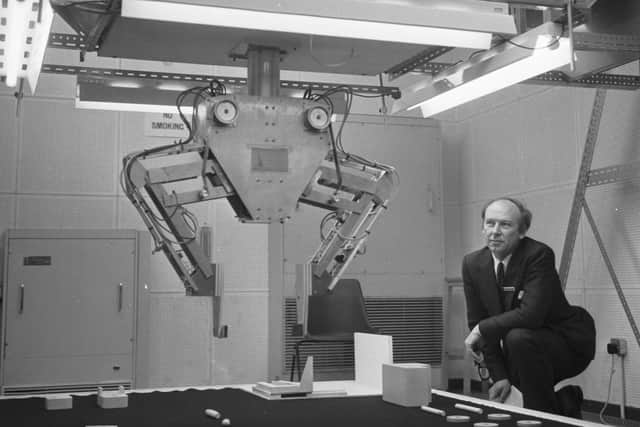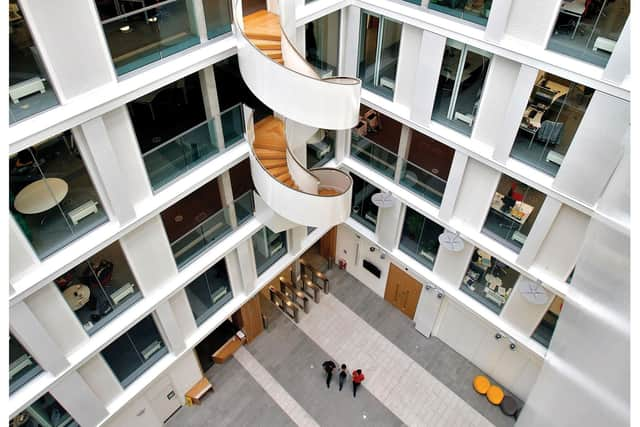The wartime code-breaker who brought Artificial Intelligence research to 1960s Edinburgh


This year marks 60th of AI research at the University of Edinburgh, with the roots stretching back to 1963 and the celebrated Donald Michie. This year is also the centenary of his birth.
The code-breaker, who had worked at Bletchley Park with Alan Turing, set up the university’s first AI research unit at 4 Hope Park Square, just off The Meadows, in 1963 as artificial intelligence gathered pace globally.
The early pioneers were influenced by books such as Norbert Wiener’s Cybernetics: Or Control And Communication In The Animal And The Machine, written in 1948 – the year George Orwell’s vision of technological state control, Nineteen Eighty-Four, was also published.


Chris Williams, professor of machine learning at the University of Edinburgh’s School of Informatics, describes the foundation of a global AI community.
He says: “The meeting regarded as the founding of AI was in 1956 in Dartmouth [New Hampshire, US], organised by a founding father of the field, John McCarthy. Many key people in the early days of AI came, including one or two Britons.”
Michie is not thought to have been at that meeting, but even before the AI research unit was formed he was a world leader in the field.
He developed a system in 1961 called MENACE – Machine Educable Noughts And Crosses Engine. Williams says: “Deepmind’s AlphaGo system learned how to play Go [and beat one of the world’s top players in 2015]. Noughts and crosses is a much simpler game, but the system did learn. Michie didn’t have an electronic computer, so he used matchboxes. It’s a strong early example of a system that learns.”


MENACE was recreated at the Edinburgh International Science Festival this year, and illustrates that Scotland’s capital was very much ahead of the AI game, according to Williams.
“There were only about four places in the world doing AI in the 1960s,” he says. “Three were in the US – MIT in Boston, Carnegie Mellon in Pittsburgh and Stanford, California. Edinburgh was a world-leading centre.”
At the time, Michie published the proceedings of Machine Intelligence Workshops he organised. Another of Edinburgh’s AI pioneers, Bernard Meltzer, founded the journal Artificial Intelligence in 1970.
Christopher Longuet-Higgins and Richard Gregory arrived from Cambridge and, along with Michie, founded the university’s Department of Machine Intelligence and Perception in 1966.
Williams says the university was a melting pot of huge ideas: “Meltzer was doing work in metamathematics, trying to make computers prove theorems. Another piece of work Michie was doing was Graph Traverser, which is effectively search.
“In AI problems, you often want to carry out a search across alternatives. You start somewhere and end up with a tree of options … They were trying to create heuristics [shortcuts used to simplify problems and avoid cognitive overload] to explore that.”
Early neural networks, using algorithms to mimic the way the human brain operates, were another focus, exemplified in a 1969 paper, The Associative Net, by David Willshaw and Peter Buneman – still emeritus professors at the university – along with Longuet-Higgins.
“We can see different traditions developing,” says Williams. “The more logic-based tradition of symbolic AI, and the neural net tradition of machine learning.”
This world-leading work was happening without the computing power we now take for granted – Michie is said to have connected by phone to the University of Manchester to access computers at one point.
Williams says: “I started working in AI in the late 1980s, and when I went to Toronto, there were stories that they initially had one computer on a trolley and wheeled it around.
“They managed to get computers in Edinburgh in the late 60s. They were very expensive, as there wasn’t a mass market, so they had to be very creative and maximise what they had.”
Despite – or perhaps because of – all the great minds working on AI and related areas in Edinburgh, tensions grew. Gregory and Longuet-Higgins left in the early 1970s. A specific Department of Artificial Intelligence was created in 1974, headed by Meltzer, with the Machine Intelligence Research Unit set up to accommodate Michie’s work.
Williams says: “It’s no secret that there were intellectual tensions between the founders, about what were the important problems to focus on. For example, Longuet-Higgins founded the School of Epistemics in 1969 around the notion of cognitive science – the study of the mind and its processes. Were they trying to do AI, or cognitive science? There was probably strong competition for resources too, between this bunch of alpha males.”
Yet Edinburgh was still very much at the cutting edge with its work on Freddy the Robot (see panel), Prolog, a kind of logic programming developed by David Warren, and the meta reasoning work of Alan Bundy, who is still at the university today.
Many great AI minds passed through the university, including Geoff Hinton, “The Godfather of AI”, who recently hit the headlines by saying AI posed a genuine risk to the future of humanity.
Hinton was Williams’ PhD supervisor in Toronto. Williams says: “He was a good supervisor who ran a big group of students – he was very engaged and I learned how to do research from Geoff. I owe him an enormous debt.”
Another significant figure who did his PhD in AI at Edinburgh was Fernando Pereira, now vice-president and engineering fellow at Google. Mirella Lapata, professor of natural language processing at the School of Informatics, says: “He was one of the first people who did what we now call natural language processing – how you generate language and understand it.
“His work is mega-famous in natural language processing, and he’s been very instrumental inside and outside Google promoting it.”
Martha Palmer – the first woman to gain a PhD in artificial intelligence at the University of Edinburgh, who is now at the University of Colorado – is another highly regarded figure, deemed instrumental in the development of natural language processing.
Today, Edinburgh’s AI work comes under the aegis of the School of Informatics. It was created in 1998 (firstly as the Division of Informatics) from the Department of Artificial Intelligence, the Centre for Cognitive Science and Department of Computer Science, the Artificial Intelligence Applications Institute and the Human Communication Research Centre.
When the School began, it was dispersed over six sites. One of these sites, 80 South Bridge, which housed around 25 per cent of the school, was destroyed in the Old Town fire of December 2002. A unique collection of literature and many researchers’ personal archives were lost. In June 2008, the Informatics Forum was opened, bringing all the school’s research activities together under one roof in Crichton Street, just off George Square.
The university’s AI story continues to evolve. The Centre for Technomoral Futures, led by Professor Shannon Vallor, was created in 2020 to examine “the ethical implications of present and future advances in AI, machine learning and other data-driven technologies”. It is unlikely to be short of issues to examine.
So what would the founding fathers, especially Michie, think? Williams says: “I think he’d be tremendously excited to see the progress that has been made. He’d probably have all sorts of ideas about what we should, and shouldn’t, do.”
Find out more about 60th anniversary events at: www.ed.ac.uk/informatics
Donald Michie: A life dedicated to AI research
Donald Michie was born in Rangoon, Burma, in November 1923 and won a scholarship to study Classics at Oxford.
He then trained in cryptography and was soon recruited to Bletchley Park, the country house which housed Britain’s top code-breakers during the Second World War.
Michie was assigned to a department tasked with breaking the Germans’ “Tunny” code, and worked alongside Alan Turing and other celebrated codebreakers.
Later, after initially pursuing studies in mammalian genetics, Michie came to Edinburgh where he rose to prominence by creating MENACE, and launching the first AI research unit in 1963.
He remained at Edinburgh until founding The Turing Institute, an AI research company, in Glasgow in 1983, carrying out cutting-edge research and consultancy in AI and robotics. It closed in 1994 after financial difficulties.
Michie remained active in AI research into his 80s, and devoted his later life to the charity The Human Computer Learning Foundation.He was married three times, and had four children. In 2007, aged 83, he was killed in a car crash with his second wife, Professor Anne McLaren, with whom he had stayed close.
His papers are now housed at the British Library.
Early robotics limited by computer power
The creativity of the early pioneers in the face of weak computing power was exemplified by Freddy the Robot – aka FREDERICK: Friendly Robot for Education, Discussion and Entertainment, the Retrieval of Information and the Collation of Knowledge.
Frederick’s son, “Freddy II” – now in the National Museum of Scotland, and pictured here with Donald Michie – was a mechanical arm fixed to an overhead gantry with a large pincer-like “hand” that could move up and down and rotate.
Two cameras mounted on the gantry enabled Freddy to look at objects on a table, which could also be moved in two directions.
Given randomly arranged parts of a wooden car and boat, Freddy II could pick out the right parts of a model and assemble them. However, this took 16 hours, because of the limited computational power available for movement control – a Honeywell H316 with 4k of memory.
Chris Williams says: “This was a hand-eye robot, which analysed the visual scene, and then moved. Freddy was a ground-breaking piece of work and brought together lots of different people to make that happen. One of the researchers was Pat Ambler, a female pioneer in robotics.”
Stephen Salter, who created the Salter’s Duck wave energy device, was also involved in the engineering.